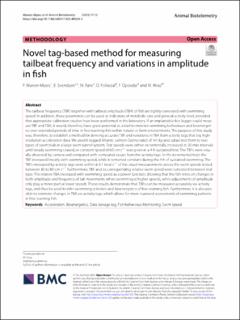| dc.contributor.author | Warren-Myers, F. | |
| dc.contributor.author | Svendsen, Eirik | |
| dc.contributor.author | Føre, Martin | |
| dc.contributor.author | Folkedal, Ole | |
| dc.contributor.author | Oppedal, Frode | |
| dc.contributor.author | Hvas, Malthe | |
| dc.date.accessioned | 2023-10-24T11:02:40Z | |
| dc.date.available | 2023-10-24T11:02:40Z | |
| dc.date.created | 2023-04-11T12:53:05Z | |
| dc.date.issued | 2023 | |
| dc.identifier.citation | Animal Biotelemetry. 2023, 11, 12. | en_US |
| dc.identifier.issn | 2050-3385 | |
| dc.identifier.uri | https://hdl.handle.net/11250/3098361 | |
| dc.description.abstract | The tailbeat frequency (TBF) together with tailbeat amplitude (TBA) of fish are tightly correlated with swimming speed. In addition, these parameters can be used as indicators of metabolic rate and general activity level, provided that appropriate calibration studies have been performed in the laboratory. If an implantable bio-logger could measure TBF and TBA, it would, therefore, have great potential as a tool to monitor swimming behaviours and bioenergetics over extended periods of time in free roaming fish within natural or farm environments. The purpose of this study was, therefore, to establish a method for deriving accurate TBF and variations in TBA from activity tags that log high-resolution acceleration data. We used 6 tagged Atlantic salmon (Salmo salar) of ≈1 kg and subjected them to two types of swim trials in a large swim tunnel system. Test speeds were either incrementally increased in 20-min intervals until steady swimming ceased, or constant speed of 60 cm s−1 was given in a 4-h sustained test. The TBFs were visually observed by camera and compared with computed values from the activity tags. In the incremental trials the TBF increased linearly with swimming speed, while it remained constant during the 4 h of sustained swimming. The TBFs measured by activity tags were within ± 0.1 beat s−1 of the visual measurements across the swim speeds tested between 30 to 80 cm s−1. Furthermore, TBF and its corresponding relative swim speed were consistent between trial type. The relative TBA increased with swimming speed as a power function, showing that the fish relies on changes in both amplitude and frequency of tail movements when swimming at higher speeds, while adjustments of amplitude only play a minor part at lower speeds. These results demonstrate that TBFs can be measured accurately via activity tags, and thus be used to infer swimming activities and bioenergetics of free roaming fish. Furthermore, it is also possible to estimate changes in TBA via activity tags which allows for more nuanced assessments of swimming patterns in free roaming fish. | en_US |
| dc.language.iso | eng | en_US |
| dc.publisher | BioMed Central | en_US |
| dc.rights | Navngivelse 4.0 Internasjonal | * |
| dc.rights | Navngivelse 4.0 Internasjonal | * |
| dc.rights.uri | http://creativecommons.org/licenses/by/4.0/deed.no | * |
| dc.title | Novel tag-based method for measuring tailbeat frequency and variations in amplitude in fish | en_US |
| dc.title.alternative | Novel tag-based method for measuring tailbeat frequency and variations in amplitude in fish | en_US |
| dc.type | Peer reviewed | en_US |
| dc.type | Journal article | en_US |
| dc.description.version | publishedVersion | en_US |
| dc.rights.holder | © The Author(s) 2023. Published by BioMed Central. | en_US |
| dc.source.pagenumber | 13 | en_US |
| dc.source.volume | 11 | en_US |
| dc.source.journal | Animal Biotelemetry | en_US |
| dc.source.issue | 1 | en_US |
| dc.identifier.doi | 10.1186/s40317-023-00324-3 | |
| dc.identifier.cristin | 2139956 | |
| dc.source.articlenumber | 12 | en_US |
| cristin.ispublished | true | |
| cristin.fulltext | original | |
| cristin.qualitycode | 1 | |

